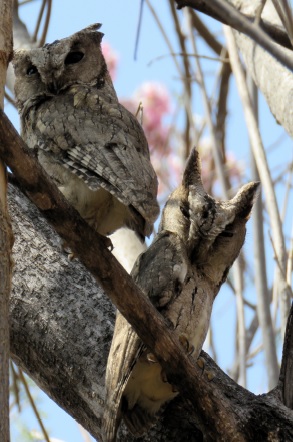They have been around in the foyer of the Senior School for years now, occupying the beam close to the tiles. They can be quite unobtrusive and with their mottled plumage, it takes a while to locate them on their secret perch, where they seem to be sleeping most of the day. Yes, I am referring to the Indian Scops Owl (Otus bakkamoena) pair. The word “scops” is a Greek word that means small, eared owl.
Last week, for once, they decided to leave their secret perch and bask in full sunshine. They were seen perched on the leafless branches of the Gliricidia tree in the courtyard. They were quite unmindful of my presence as I clicked these pictures but seemed uncomfortable when some students joined me. It was quite surprising that despite being out in the open, few people noticed them and they seemed to merge with the tree branches.
These birds become active once the sun sets and at dusk, they come down from their perch and stretch their wings. They also perch on the frame of the large hoopoe portrait before flying out to hunt their prey, which is mainly small insects and animals. They have a characteristic call: “WUT?” which they utter at dusk and through the night. They can be noisier during the breeding season which is January-March. I have heard their repeated calls several times during the breeding season. They nest in tree-cavities.
Dr Santharam















